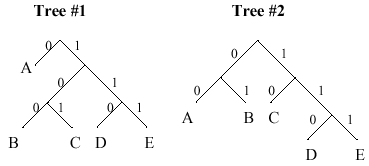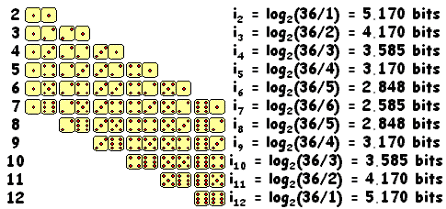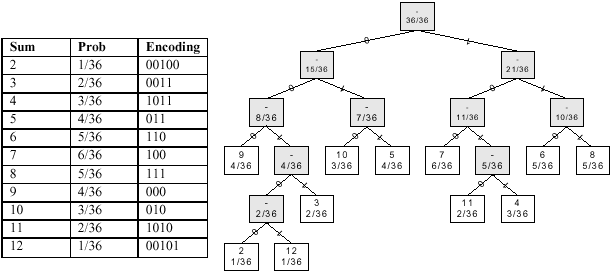Using the simple "greedy" algorithm described above:
S = {A/0.15 E/0.4 I/0.15 O/0.15 U/0.15}
arbitrarily choose O & U
encoding: "0" => O, "1" => U
S = {A/0.15 E/0.4 I/0.15 OU/0.3}
choose A & I
encoding: "0" => A, "1" => I
S = {AI/0.3 E/0.4 OU/0.3}
choose AI & OU
encoding: "00" => A, "01" => I, "10" => O, "11" => U
S = {AIOU/0.6 E/0.4}
choose E & AIOU
encoding: "0" => E, "100" => A, "101" => I, "110" => O, "111" => U
S = {AEIOU/1.0}
Note that the assignments of symbols to encodings "0" and "1"
were arbitrary and could have been swapped at each level. So, for example,
swapping the encoding at the last step would have resulted in
encoding: "1" => E, "000" => A, "001" => I, "010" => O, "011" => U
which achieves the same average bits/symbol as the previous encoding.
 Someone picks a name out of a hat known to contain the names of 5
women and 3 men, and tells you a man has been selected.
How much information have they given you about the selection?
Someone picks a name out of a hat known to contain the names of 5
women and 3 men, and tells you a man has been selected.
How much information have they given you about the selection?
 X is an unknown 8-bit binary number. You are given another
8-bit binary number, Y, and told that the Hamming distance
between X and Y is one. How many bits of information about
X have you been given?
X is an unknown 8-bit binary number. You are given another
8-bit binary number, Y, and told that the Hamming distance
between X and Y is one. How many bits of information about
X have you been given?


